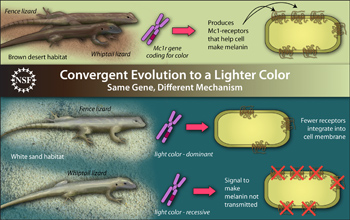Multimedia Gallery
Adaptation and speciation studies (Image 11)
Whiptail and fence lizards are dark-colored on dark soil; however, when found on white sand they exhibit a light skin color that helps protect them from predators. It is a case of convergent evolution involving the same Mc1r gene coding for color. In the dark ancestral lizards, the gene codes for Mc1-receptors that help cells, called melanocytes, produce the melanin that makes the animal dark. In the white, sand-dwelling fence lizard, one copy of the mutation is sufficient to cause fewer Mc1-receptors to integrate into cell membranes, therefore resulting in a lighter color. In the whiptail lizards, the mutation is recessive and requires two copies of the gene. This combination does not affect the number of receptors integrated into cell membranes, but adversely affects their ability to transmit signal -- arriving at the same result on the macro level: a lighter lizard.
Researchers from the lab of Erica Bree Rosenblum, an assistant professor in the Department of Environmental Science Policy and Management at the University of California, Berkeley, are studying adaptation and speciation at White Sands, and are working to understand how natural selection can lead to rapid evolutionary change.
This research was supported by National Science Foundation grant DEB 03-09327. The research is now supported by an NSF CAREER (Faculty Early Career Advancement) program award, as of 2011. For more information about this research, see the NSF press release Looks Can Be Deceiving, or visit the Rosenblum lab website Here. (Date of Image: 2000-2009) [Image 11 of 11 related images. Back to Image 1.]
Credit: Zina Deretsky, National Science Foundation
Images and other media in the National Science Foundation Multimedia Gallery are available for use in print and electronic material by NSF employees, members of the media, university staff, teachers and the general public. All media in the gallery are intended for personal, educational and nonprofit/non-commercial use only.
Images credited to the National Science Foundation, a federal agency, are in the public domain. The images were created by employees of the United States Government as part of their official duties or prepared by contractors as "works for hire" for NSF. You may freely use NSF-credited images and, at your discretion, credit NSF with a "Courtesy: National Science Foundation" notation.
Additional information about general usage can be found in Conditions.
Also Available:
Download the high-resolution JPG version of the image. (623 KB)
Use your mouse to right-click (Mac users may need to Ctrl-click) the link above and choose the option that will save the file or target to your computer.



